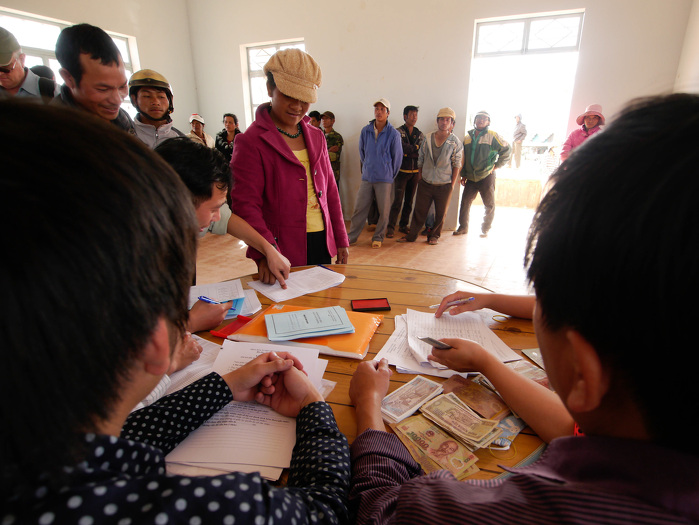Greater Mekong Subregion Biodiversity Conservation Corridors Project (Additional Financing)
Details
|
Project |
40253-023 |
|
Related Projects |
Search |
|
Type |
Grant |
|
Sector |
Agriculture, Natural Resources and Rural Development |
|
Country |
Viet Nam |
|
Start |
2015 |
|
End |
2020 |
|
Status |
Ongoing |
|
Last Edited |
05 Jul 2021 |
Funding
US$('000) 4,540
Confinancing Source: Global Environment Facility (GEF)
Project Description
The grant is an additional financing to the ongoing loan of Biodiversity Conservation Corridors (BCC) Project, to be funded under the Global Environment Facility (GEF). It is expected to address the ongoing fragmentation of the forest landscape and its ability to provide critical ecosystem services such as carbon storage, sustainable biodiversity and local livelihoods.
Progress
(as of March 2021)
Ongoing. The project- overall implementation progress has been approximately achieved at about 75% (as of July 2019) against an elapsed time of 98%. The Memo requesting for an approval of first extension of grant closing date for an additional 12 months, from 30 September 2019 to 30 September 2020- is being internally processed.
News and Multimedia

The sustainably managed biodiversity corridors in Cambodia, the Lao PDR, and Viet Nam.
Source: ADB Flickr

Patrollers task in maintaining the general well-being of the forest.
Source: ADB Flickr

The Biodiversity Corridor program involves Kâho natives like Cil Yu Ha Vuong, 72, who patrols the forests along with fellow community members.
Source: ADB Flickr

The town of Thanh My is one of many that lie amidst the forests of A Vuong, an important watershed that provides hydropower needed to generate electricity for Vietnam.
Source: ADB Flickr

Kâho villagers receive Payment for Forest Environment Services from Bidoup Nui Ba National Park staff at a community center in Da Nhim.
Source: ADB Flickr

Kâho rangers take a breather after spending a day out in the forests. Around 4 to 5 villagers accompany full-time forest rangers on regular patrols that involve general conservation and law enforcement work. The Biodiversity Corridor Program raises awareness amongst the local communities about the need to preserve the surrounding environment. Mainstreaming Environment for Poverty Reduction (MEPR) is a financed by the Poverty and Environment Fund (PEF) that promotes accelerated learning and innovative approaches on poverty-environment linkages.
Source: ADB Flickr

Hillside in Da Nhim shows some evidence of logging. Despite its status as a protected area, the cutting of trees is still permitted on a very limited scale at the Bidoup Nui Ba National Park. The Biodiversity Corridor Program raises awareness amongst the local communities about the need to preserve the surrounding environment. Mainstreaming Environment for Poverty Reduction (MEPR) is a financed by the Poverty and Environment Fund (PEF) that promotes accelerated learning and innovative approaches on poverty-environment linkages.
Source: ADB Flickr

Rangers head out to patrol the forests near Da Chais. The jungles in Lac Duong are an essential watershed that feeds nearby hydropower plants, and supplies water to towns and cities in Lam Dong Province. The Biodiversity Corridor Program raises awareness amongst the local communities about the need to preserve the surrounding environment. Mainstreaming Environment for Poverty Reduction (MEPR) is a financed by the Poverty and Environment Fund (PEF) that promotes accelerated learning and innovative approaches on poverty-environment linkages.
Source: ADB Flickr

Villagers from the Kâho ethnic minority patrol a pine forest near the Da Nhim commune as part of Payment for Forest Environment Services (PFES) rendered for the national park authorities. The Biodiversity Corridor Program raises awareness amongst the local communities about the need to preserve the surrounding environment. Mainstreaming Environment for Poverty Reduction (MEPR) is a financed by the Poverty and Environment Fund (PEF) that promotes accelerated learning and innovative approaches on poverty-environment linkages.
Source: ADB Flickr

Kâho villagers from the Da Chais commune prepare to go out on patrol with forest ranger Pham Huu Nhan at a Forest Protection Station in Giang Ly town. The Biodiversity Corridor Program raises awareness amongst the local communities about the need to preserve the surrounding environment. Mainstreaming Environment for Poverty Reduction (MEPR) is a financed by the Poverty and Environment Fund (PEF) that promotes accelerated learning and innovative approaches on poverty-environment linkages.
Source: ADB Flickr

Kâho villagers from the Da Chais commune prepare to go out on patrol in Da Nhim. The Biodiversity Corridor Program raises awareness amongst the local communities about the need to preserve the surrounding environment. Mainstreaming Environment for Poverty Reduction (MEPR) is a financed by the Poverty and Environment Fund (PEF) that promotes accelerated learning and innovative approaches on poverty-environment linkages.
Source: ADB Flickr

Forest rangers pose beside a replanted pine tree in Da Chais commune. Conservation, protection and police work comprises the work of these individuals. The Biodiversity Corridor Program raises awareness amongst the local communities about the need to preserve the surrounding environment. Mainstreaming Environment for Poverty Reduction (MEPR) is a financed by the Poverty and Environment Fund (PEF) that promotes accelerated learning and innovative approaches on poverty-environment linkages.
Source: ADB Flickr
- By 2022, 18,900 ha restored and an additional 16,100 ha leveraged under reduced emissions from deforestation and forest degradation for climate change mitigation compared to 2011 baseline; approximately 2,600 households with diversified livelihood assets and/or income generating opportunities; and 5.3 million labor days worth of employment generated through project related conservation and participatory restoration activities.
- By 2018, management plans and biodiversity corridor policy with legal framework in place covering around 1.93 million ha of forestland and nonforestland; biodiversity conservation corridors mapped and demarcated with cross-border arrangements for maintenance and protection between the Lao PDR and Viet Nam, and Cambodia and Viet Nam; increase in income and/or assets for target households by 40% in Cambodia and the Lao PDR, and 55% in Viet Nam compared to 2011; and at least 30% of the commune and village corridor management committee members are women.












